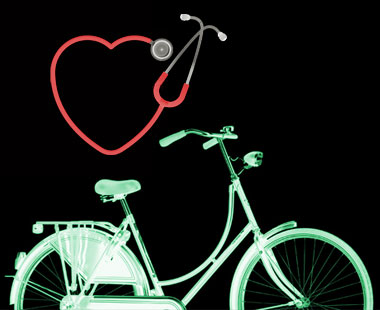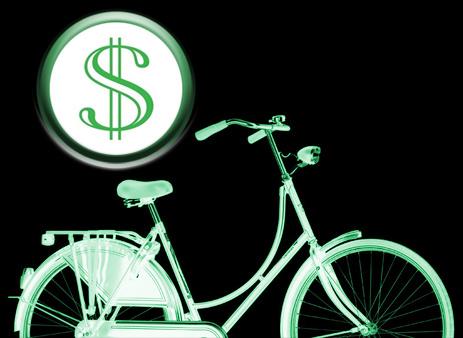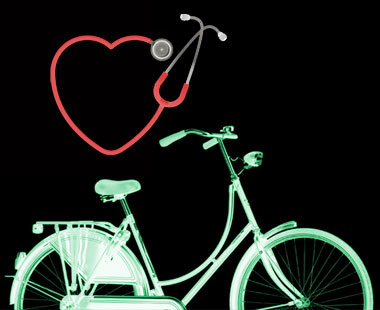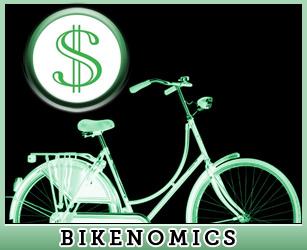This is the third column in a series focusing on the economics of bicycling.
 In the United States, we have the most expensive health care system in the world.
In the United States, we have the most expensive health care system in the world.
We collectively invest more than 15 percent of our GDP — that’s around $2 trillion, or $5,700 per person — into health care every year.
The tragedy of these enormous numbers is that they fail to stem the tide of our increasing ill health. “Most of the money we’re spending on health care is going to treat preventable chronic diseases,” Michael Pollan told Grist in 2009. Our poor diet, he added, is responsible for most of those illnesses.
But it’s not just about what we eat. The other part of that equation is our national and increasingly desperate need for physical activity. We need to rethink our transportation system and built environment on the same scale as Pollan and others have reconsidered our agricultural system.
It has become obvious that we can’t afford to keep doing things the same old autocentric way.
For a fraction of the cost of the world’s most expensive health care system, we could all enjoy the world’s best bicycling and walking infrastructure — and with it much, much better health than we enjoy now.
Even minor investments in quality bicycle and walking transportation infrastructure, particularly at bottlenecks like bridges, leads directly to increased physical activity for people who live nearby.
A recent analysis of the health savings resulting from the bicycle infrastructure in Portland, Ore, came up with stunning results. If the city builds out only the infrastructure it currently plans, the researcher found, it will break even by 2015. By 2030, Portland will have saved $800 million — partly in fuel costs but primarily in health care and the value of reduced mortality. For every $1 we spend, $5 is saved.
And that doesn’t take into account a multitude of other factors. It’s been shown again and again that the benefits of bicycling outweigh the risks, that not bicycling is more dangerous in the long run, and that being sedentary is worse for your health than nearly anything else. When kids, particularly, don’t get enough physical activity and good food, they are set up for a lifetime of ill health.
Then there’s the mental health factor. People who bicycle and walk to work love their commutes [PDF], whereas everyone else is stressed [PDF], even pathologically so. Stress is often overlooked as an indicator and instigator of poor health.
And bicycling isn’t just good for your personal health. There’s also a significant public health benefit to having fewer people driving.
Air quality is a big one. Cars produce secondhand smoke that none of us can avoid. A parade of studies over the last few decades have steadily linked living near freeways to heart disease, lung cancer, asthma, impaired lung development, and even autism.
Even being sealed in a car doesn’t protect you from the perils of concentrated car exhaust [PDF].
Car crashes cost the country $230 billion in 2000 alone. Only $33 billion of that was spent on medical costs — but to put that in perspective, that’s the same amount as that year’s federal highway budget. Worse, in 2009 car crashes caused nearly 34,000 deaths and 2.217 million injuries, many of them serious enough to prevent victims from navigating our car-oriented landscape in anything but a car.
What do we do about this? How do we address the health care crisis through reforming our transportation system?
We’d be much healthier, we’re always being told, if only we could get more physical activity. Bicycle transportation is uniquely suited to fill this requirement. Bicycling is uniquely suited for quickly and flexibly getting around a city designed for cars. And riding a bike for transportation is as good a workout as exercising at the gym. The cost, time, stress, and inconvenience of exercise evaporates with the bicycle.
If only we all could take advantage of it. We are blessed in this country with a chorus of voices urging people to exercise more and try riding a bike — but very little is being done to make that option safe and comfortable for everyone.
I know, because I grew up in suburbia, that people don’t eat unhealthy food and sit on the couch all day out of laziness. They end up falling into those behaviors because the options aren’t there, or the cost — in money, time, and stress — of living differently is simply too high.
Of course we want better options. As many as 60 percent of Americans would like to ride more, and most of us already have bikes stashed in the basement or garage. But we don’t feel safe, and often that’s because there aren’t safe or convenient routes for us to take.
Fortunately, that doesn’t stop everyone from getting on a bike. And the more people out there riding, the safer everyone becomes, whether or not bicycling is an option for them individually.
It would be absurd to suggest that bikes will solve our health care crisis or that they can eliminate the political and economic machinations that continue to deepen it. But bicycling, like food, is one of the few areas where people can directly and concretely address the health care crisis in the context of our community.
By improving our own health and working towards healthier cities, we’re also taking money from a health care system that doesn’t improve our health. In this light, bicycling for transportation isn’t so much a lifestyle choice as it’s a form of civic action.
Next: “The economic case for on-street bike parking.”



